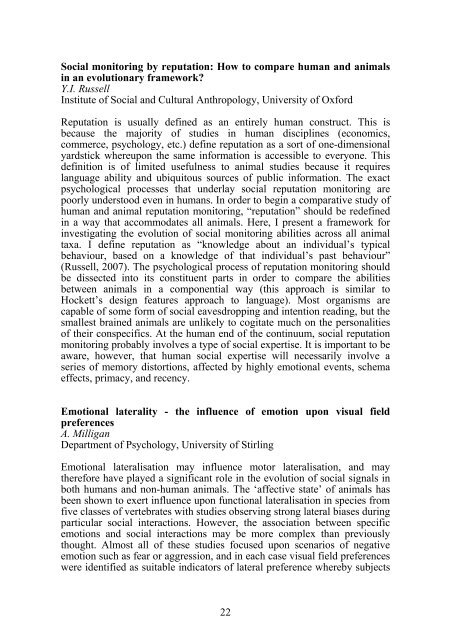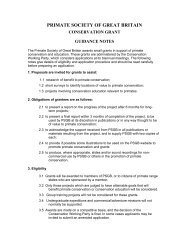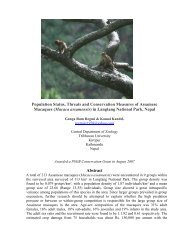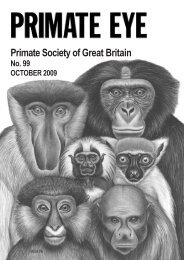2010 Vol 101.pdf (1.63mb) - Primate Society of Great Britain
2010 Vol 101.pdf (1.63mb) - Primate Society of Great Britain
2010 Vol 101.pdf (1.63mb) - Primate Society of Great Britain
Create successful ePaper yourself
Turn your PDF publications into a flip-book with our unique Google optimized e-Paper software.
Social monitoring by reputation: How to compare human and animals<br />
in an evolutionary framework?<br />
Y.I. Russell<br />
Institute <strong>of</strong> Social and Cultural Anthropology, University <strong>of</strong> Oxford<br />
Reputation is usually defined as an entirely human construct. This is<br />
because the majority <strong>of</strong> studies in human disciplines (economics,<br />
commerce, psychology, etc.) define reputation as a sort <strong>of</strong> one-dimensional<br />
yardstick whereupon the same information is accessible to everyone. This<br />
definition is <strong>of</strong> limited usefulness to animal studies because it requires<br />
language ability and ubiquitous sources <strong>of</strong> public information. The exact<br />
psychological processes that underlay social reputation monitoring are<br />
poorly understood even in humans. In order to begin a comparative study <strong>of</strong><br />
human and animal reputation monitoring, “reputation” should be redefined<br />
in a way that accommodates all animals. Here, I present a framework for<br />
investigating the evolution <strong>of</strong> social monitoring abilities across all animal<br />
taxa. I define reputation as “knowledge about an individual’s typical<br />
behaviour, based on a knowledge <strong>of</strong> that individual’s past behaviour”<br />
(Russell, 2007). The psychological process <strong>of</strong> reputation monitoring should<br />
be dissected into its constituent parts in order to compare the abilities<br />
between animals in a componential way (this approach is similar to<br />
Hockett’s design features approach to language). Most organisms are<br />
capable <strong>of</strong> some form <strong>of</strong> social eavesdropping and intention reading, but the<br />
smallest brained animals are unlikely to cogitate much on the personalities<br />
<strong>of</strong> their conspecifics. At the human end <strong>of</strong> the continuum, social reputation<br />
monitoring probably involves a type <strong>of</strong> social expertise. It is important to be<br />
aware, however, that human social expertise will necessarily involve a<br />
series <strong>of</strong> memory distortions, affected by highly emotional events, schema<br />
effects, primacy, and recency.<br />
Emotional laterality - the influence <strong>of</strong> emotion upon visual field<br />
preferences<br />
A. Milligan<br />
Department <strong>of</strong> Psychology, University <strong>of</strong> Stirling<br />
Emotional lateralisation may influence motor lateralisation, and may<br />
therefore have played a significant role in the evolution <strong>of</strong> social signals in<br />
both humans and non-human animals. The ‘affective state’ <strong>of</strong> animals has<br />
been shown to exert influence upon functional lateralisation in species from<br />
five classes <strong>of</strong> vertebrates with studies observing strong lateral biases during<br />
particular social interactions. However, the association between specific<br />
emotions and social interactions may be more complex than previously<br />
thought. Almost all <strong>of</strong> these studies focused upon scenarios <strong>of</strong> negative<br />
emotion such as fear or aggression, and in each case visual field preferences<br />
were identified as suitable indicators <strong>of</strong> lateral preference whereby subjects<br />
22






